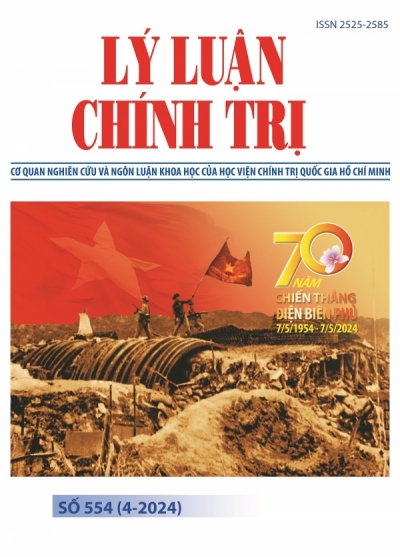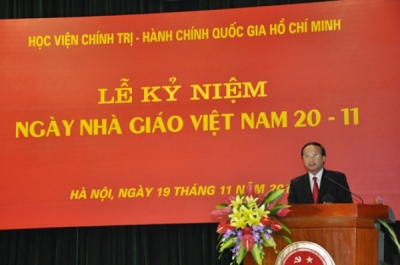For authors
1. General regulations
- Language
Articlessubmitted to the Political Theory Journal is must be written in Vietnamese, using Unicode font and the Latin writing system. In case of citing, referencing documents in a language belonging to another system, it must be transliterated into the Latin writing system.
- Copyright terms and data usagerights
The Political Theory Journal does not accept and use any articles whose content, in whole or inapart, has been published in otherplaces (journal, books or newspapers).
Once an article has been submitted to the Political Theory Journal, the author has the responsibility not to submit and publish the article in other journals without receiving a refusal to publish from the Editorial Board of the Political Theory Journal.
Authorsareresponsible for the content and accuracy of the article (including the accuracy of citations in the article), and the copyright legality of the article. Authorsshouldbe responsible for obtaining permission to use data from individuals and organizations that manage/own the data. Figures and data used in the article must be cited specifically and accurately.
- Article authorship
If the article has more than one author, it is necessary to clearly state who is responsible for contacting the Journal Editorial Board during the editing and review process.
- Submissionmethod
Authors can submit articles to the Political Theory Journal via email tcllct.hcma@gmail.com
2. Presentation of text
- Technical standards
The article should be drafted using Microsoft Word software, font size 14, Times New Roman (Unicode) font, 1.5-line spacing, top margin 2cm, bottom margin 2cm, left margin 3cm, right margin 2cm.
Articles submitted to the printedjournalshouldbe 4,000-6,000 words long (about 10-14 A4 pages).
- Information components
The article consists of 2 separate parts: (i) Author information and (ii) Article content
(i) Author information includes:
1. Article title
2. Author's full name
3. Pseudonym(if any)
4. Academic titles and degrees
5. Work unit
6. Contact information: address, phone number, email
7. Bank account number, tax code/ID card
8. Commitment to the legal copyright of the article, commitment that the article has not been published anywhere (journals, booksor newspaper)before, commitment not to submit the article to other journalsor editorial offices while waiting for approval.
In cases where the article is authored bytwo or more authors, the submitting authormust take responsibility for ensuring that all co-authors have seen and approved the final version of the manuscript and have agreed to its submission for publication in Political Theory Journal, and responsible for providingcomplete information of all the article’s co-authors.
(ii) The content of the article should meetthe standards of a scientific article, as specified in the Basic article components sectionbelow.
- Basic article components
An article submitted to the Political Theory Journal is presented in the form of a scientific article including the following basic components:
+ Article name:
For the printed Journal: capitalized, bold, no more than 20 words.
For the online Journal: lowercase, bold, no more than 20 words
+ Abstract:Summarize the main content and points out the results, contributions, and innovations of the article.
For the printed Journal: no more than 200 words
For the online Journal: no more than 100 words
+ Keywords:includes from 3 to 5worlds or phrasesdirectly related to the article
+Problem statement/ Introduction:State the reason for the topic selection and the importance of the research problem, pointing out the main point that the research focuses on solving.
+ Research overview and/or theoretical basis/research method:
Overview of related research works, pointing out gaps and/or Theoretical basis/theoretical framework of the article.
Research method: state the research method used in the article
+ Research results:Analyze the research problem, point out the research results.
+ Solutions/ Recommendations/ Lessons: Based on the research results, point out recommended solutions for managers, policy makers to address the issue.
+Conclusion
+ Notes/citations/ and references:are specified in the section on Abbreviations, capitalization, data, citations section
- Specifications for presentingheadings, tables, diagrams, photos, drawings
The major headings in the article content are numbered consecutively according to the Arabic coefficients 1, 2, 3…, the heading names are in lowercase, bold, left-aligned format. Level 1 subsections use a, b, c... with parentheses after them to denote order. Subsection names are in lowercase, bold, and italic font.
The data tables in the article are formatted in table format in Microsoft Word and uniformly recorded as Table.
Graphs, charts, and diagrams in the article are uniformly labeled as Figures. Authors need to attach original excel files of graphs, charts and the original files of graphic images. For JPEG and TIF format image files, photo resolution greater than 300dpi is required.
Tables and figures in the article shouldbe presented in Vietnamese, and numbered separately, in consecutive order. For example: Table 1, Table 2, Figure 1, Figure 2…
Names of tables and figures placed above the table/figure and formatted in bold. If there is a common unit of calculation for the whole table and figure, place it in the upper right of the table, in parentheses, for example: (Unit: million VND/person/year). Tables and figures should be cited at the bottom, formatted in italics, not bold, right-aligned.
3. Abbreviations, capitalization, data, citations in the article
- Abbreviations
Only abbreviate common words that do not need explanation, for example: Socialism, Communism, Capitalism, People's Committee, People's Council, Fatherland Front, Industry, OS, GDP, UNESCO, ASEAN, WTO, IMF,ect.
In one article, do not use more than 2 abbreviations (in addition to the common words above). Abbreviations are only used after being introduced by the author after the full phrase the first time it appears in the article.
Do not use the symbol “=” instead of the word “equal”, the symbol“&”instead of the word “and”.
- Capitalization
The general rule is to capitalize personal names of people (both surnames, middle names and given names), the first letter of organization names, names of places, major holidays... when they are nouns.
Capitalize the names of major historical, political, and social events that mark the progressive development of a nation or an entire era (for example: August Revolution, Russian October Revolution,...).
The words Party and State, when used as common nouns and adjectives, are still written in lower case (for example: communist parties, state management, party organizations and state employees, state-owned enterprises. ..).
Names of administrative areas with all capital letters are proper nouns (for example: Nghia Tan ward, Hoan Kiem district, Hai Duong province... (the words "ward", "district", "province"... is a common noun so is written in lower case).
If the name of an agency or organization consists of a phrase, capitalize the first letter and capitalize the nouns that serve as identifiers with separate identifying functions (for example: Department of Organization; Party Central Committee of Inspection...).
Names of land and sea areas written in capital letters have a unique identifying function (for example: West, North, Tonkin, Cochinchina, Gulf of Tonkin, Pacific Ocean...).
The names of people and geographical names of Vietnam's ethnic minorities are written in Vietnamese and the ethnic names are noted in parentheses as in the Vietnam Encyclopedia. For example: Dak Lac (Dak Lak), Bac Can (Bac Kan).
Names of documents and resolutions such as Documents of the 10th National Congress, Resolution of the 5thConference of the 8thCentral Executive Committee, etc. can be shortened and written in lower case as “Documentsof the 10th Congress”, "Resolution of the 5th Plenum of the 8thCentral Committee", etc.
- Date format
Format dates using hyphens, for example January 1, 2024 (1-1-2024).
- Number format
The comma (,) represents a group of decimal numbers; The dot (.) symbolizes the grouping of numbers in units, tens, hundreds, thousands...
- Measure
Using the metric system, if the author uses units of another system, it is necessary to convert to the metric system. For example, 1 mile (equivalent to 1.61km)
- Quoteor citation
Number the citations with Arabic numbers in parentheses at the end of the phrase or clause, or sentence, paragraph, idea, spirit of the sentence, or quote according to each article or news, not each page.
There are 2 ways to cite in an article:
(i) Quoting a complete phrase, clause, sentence, or paragraph of prose must be enclosed in quotation marks and accurately reflect every letter (uppercase, lowercase, printed, italicized, bolded, etc.) ), and punctuation. . In cases where some words in a sentence, one or several sentences in a quoted passage are omitted, ellipses should be used in their place, still within quotation marks(...).
(ii) Quoting ideas or the spirit without quoting verbatim, should not be used quotation marks. When using, add the word See.
Notes on cited documents: placed at the bottom of the page, numbered consecutively according to Arabic numerals in parentheses (1), (2), (3)..., clearly written in order: author's name, title of the word, volume, publisher, place of publication, year of publication, referenced page(s).
For example: (1) Marx and Engels: Complete works, vol. 3, National Political Publishing House, Hanoi, 1995, p.9.
References: placed at the bottom of the page, below the cited documents, numbered consecutively according to Arabic numerals with a dot after: 1. , 2. , 3. , ... and clearly stated in the same order cited documents.
For example: 1. Ho Chi Minh: Complete works, vol.2, National Political Publishing House, Hanoi, 1995.
Journal Archives
Journal Archives
Media
Photo Gallery
Contact us





